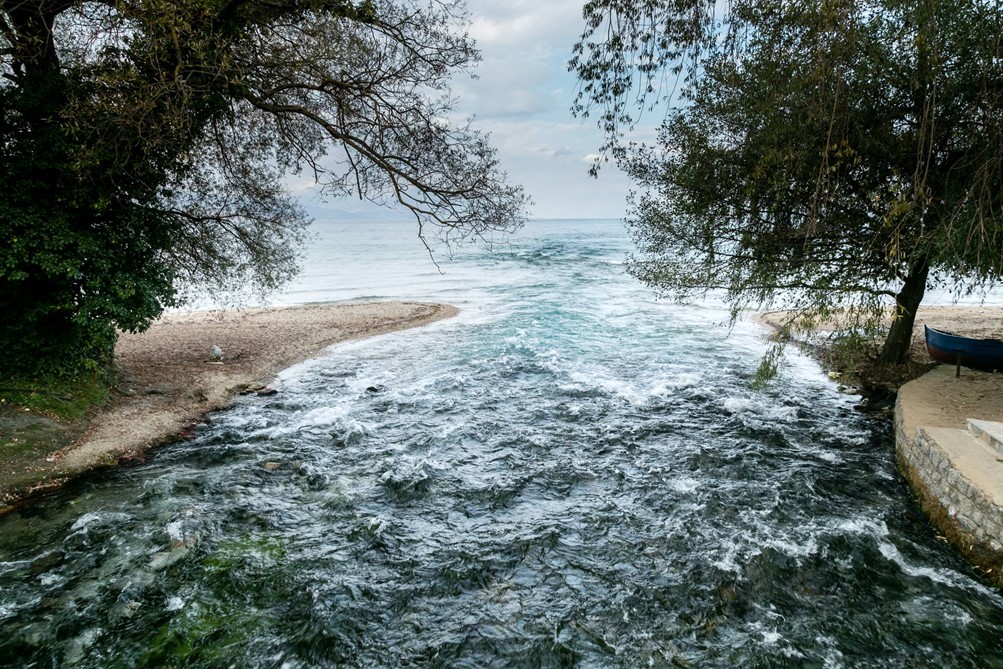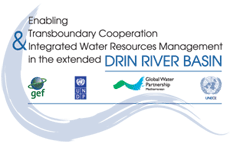Developing the first Flood Risk Management Plan for the Drin River Basin
The Drin river riparians Albania, Kosovo*, Montenegro and North Macedonia are increasingly affected by the impacts of climate change, experiencing periods of extreme heat in the summer months and heavy rainfall during the cooler seasons, accompanied by droughts and floods with severe consequences for society, economy and nature. Their institutional framework for flood risk management is highly fragmented in terms of competencies and suffers from overlapping responsibilities of institutions. National flood management plans pay little or no attention to transboundary impacts while according to the EU Floods Directive, European Member States must coordinate their flood risk management in shared river basins. [1]
Moreover, flood management in the Drin Riparians is focused on controlling floods by draining flood water swiftly to the next water body, storing flood water temporarily, or diverting the river flow away from communities, through river engineering works. An essentially sectoral approach that accounts mostly for flood control infrastructure. There is no basin flood risk management plan that addresses climate-related flood risks, flood risk management investments are not supported by robust climate risk analysis, investment plans are non-existent and there isn’t a comprehensive financial risk transfer mechanism to address flooding.

The “Integrated Climate-resilient Transboundary Flood Risk Management in the Drin River Basin in the Western Balkans” Project 2019-2024 (Drin FRM Project), funded by the Adaptation Fund and implemented by UNDP and GWP-Med for Component 2 of the Drin FRM Project, is supporting the development of the first Flood Risk management Strategy and Plan for the Drin Basin.
A Basin heavily hit by climate change with severe consequences for livelihoods
The Drin Basin is a complex water system that provides a wealth of services to 1.6 million people such as energy supply, recreation and tourism, fisheries, water supply for irrigation and domestic uses and sustenance of unique endemic biodiversity. Over the last decade, extreme phenomena such as floods, characterized by a more extreme and rapid increase in water levels, are increasingly frequent. In Albania, where data exist, the average expected annual losses from floods are estimated at roughly $3.2 million USD. According to calculations, total losses for the entire basin are estimated roughly at $10 million USD.
From traditional management of flood risk at national level to integrated management of flood risk at the basin level.

The Drin FRM project aims to assist riparian countries in the implementation of an integrated climate-resilient river basin flood risk management approach and the development of the first Flood Risk Management Plan for the River Basin. Structured around 3 Components, the project will improve their capacity to manage flood risk at regional, national and local levels and includes an array of measures such as prevention, preparedness and recovery measures from floods that complement protection measures that countries usually implement. Importantly, it will also enhance community resilience in the basin to climate-induced floods.
Component 1: Hazard and Risk Knowledge Management Tools,
Component 2: Transboundary institutional, legislative and policy framework for Flood Risk Management and
Component 3: Community-based climate change adaptation and FRM interventions
Under Component 2, GWP-Med coordinates the development of the first Flood Risk Management Strategy (FRMS) and Action Plan (FRMP) for the Drin Basin based on the principles of Integrated Flood Management (IFM) abiding by the EU acquis. The Action Plan, which stipulates tangible recommendations in a specific timeframe, together with the Strategy will serve as a policy document that will provide a paradigm-shift and operationalize activities leading to the achievement of the strategic goals set for the basin. Both documents serve directly for the implementation of specific flood related actions- jointly agreed within the Drin Strategic Action Programme (SAP), endorsed by ministers and high-level representatives of the Drin Riparians in 2020 .

The need for coordination among the countries and a joint approach to flood risk management is directly related to the Drin Riparians’s vision as this was stipulated within the Drin Memorandum of Understanding (link to page) signed by their competent ministers in 2011, “to promote joint action for the coordinated integrated management of the shared water resources in the Drin Basin, as a means to safeguard and restore to the extent possible the ecosystems and the services they provide, and to promote sustainable development across the Drin Basin." The Parties to the MoU agreed to undertake concrete short-, medium- and long-term actions to address the transboundary issues, towards the integrated management of the Basin. For the implementation of the Drin MoU a process was put in place called the Drin Coordinated Action (DRIN CORDA) while action for the MoU’s implementation was financed by the Global Environmental Facility under the GEF Drin Project (link to page). Implemented by the United Nations Development Program (UNDP) and executed by the Global Water Partnership (GWP), through GWP-Med together with the UNECE, the project promoted joint management of the shared waters of the transboundary Drin River Basin. This was undertaken by GEF through a GEF inspired mechanism known as the DRIN/SAP process. The endorsement of the SAP established clear priorities for action to develop cooperation measures to minimize risks of disasters due to extreme natural phenomena and climate change by 2030.
* This designation is without prejudice to positions on status, and is in line with UNSCR 1244/1999 and the ICJ Opinion on the Kosovo declaration of independence.
*A recent review of the legal framework for flood management in the Drin Basin carried out under the Drin FRM project shows that national flood legislation is based on the provisions of the EU Floods Directive (EUFD), as all Drin Riparians are in EU accession/candidate status, although with different levels of harmonization and implementation achieved.
[1] Full alignment with EU acquis is mandatory in the, currently ongoing, process of Drin riparian's accession to the European Union. Countries are legally committed and obliged by this, as they have signed a Stabilisation and Association Agreement
There are currently no items in this folder.





